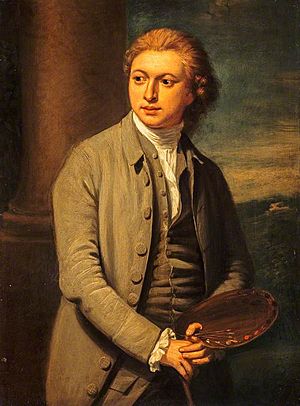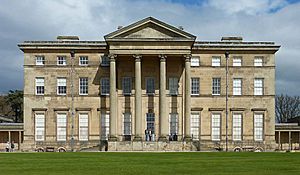George Steuart (architect) facts for kids
Quick facts for kids
George Steuart
|
|
|---|---|

Portrait of George Steuart, attributed to William Beechey
|
|
| Born | c. 1730 Atholl, Perthshire
|
| Died | 20 December 1806 (aged 75–76) Dougals, Isle of Man
|
| Occupation | Architect |
| Years active | c. 1770–1806 |
| Children | Robert Steuart |
| Buildings | Attingham Hall, St. Chad's Church, Castle Mona |
George Steuart (born around 1730 – died 20 December 1806) was a talented Scottish architect. He was born in Atholl, a region in Perthshire, Scotland. However, he spent most of his life working in London. Later in his life, he moved to the Isle of Man.
George Steuart was very lucky to have the support of the Dukes of Atholl throughout his career. This support helped him get many important jobs. Some of his most famous buildings that you can still see today include Attingham Hall and St. Chad's Church in Shropshire, England. He also designed Castle Mona on the Isle of Man.
Contents
George Steuart's Life and Work
George Steuart was born in Atholl, Perthshire, around the year 1730. By 1749, he had moved to London, where he started working as a house-painter. In 1766, he got an important job as a painter for the Board of Ordnance, which was a government department.
Becoming an Architect
Steuart's first known project as an architect was designing a town house for John Murray, 3rd Duke of Atholl. This house was finished in 1770. After this, Steuart began working full-time as an architect in London. He had offices first on Berners Street and then on Harley Street.
His buildings often showed a "neo-classical" style. This means they used ideas from ancient Greek and Roman architecture. He liked to use tall, thin columns and narrow windows. His designs often had very plain, smooth walls, which some people thought looked a bit severe.
Famous Buildings
One of the best examples of his work is Attingham Hall in Shropshire. He built this grand house between 1783 and 1785.
Another interesting building he designed is St. Chad's Church in Shrewsbury. For this church, he chose a very unusual circular shape. He also designed a unique three-tiered steeple, which was different from most churches at the time.
Working with the Dukes of Atholl
George Steuart had a very close relationship with his main supporters, the 3rd and 4th Dukes of Atholl. He stayed in touch with them throughout his life. We know this because about a hundred letters between them still exist.
In these letters, Steuart didn't just talk about building projects. He also shared news and gossip from London. Their relationship was quite special for the time. Steuart often helped the Dukes with things that weren't about architecture. For example, he would help them with business deals or even find doctors for them in London.
In return, the Dukes gave Steuart many jobs. They also wrote letters to their powerful friends, recommending Steuart's work. This helped him meet important people in society.
Moving to the Isle of Man
In 1793, Steuart received a big job to design a new pier for Douglas Harbour on the Isle of Man. He probably got this job because of the 4th Duke of Atholl. The Duke became the Governor of the island in the same year.
After starting this project, Steuart moved to the Isle of Man. He spent his final years working on several other buildings there. His most ambitious and last known project was Castle Mona. This grand building was designed as a private home for the 4th Duke of Atholl.
George Steuart passed away on 20 December 1806. He died at Lough House in Douglas and was buried at the local church in Braddan. He had one son named Robert.
Buildings Designed by George Steuart
Here is a list of some of the buildings and structures that George Steuart designed:
- Town house, Grosvenor Place, London (finished 1770)
- Garden temple, Millichope Park, Shropshire (1770)
- Other buildings at Blair Castle and Dunkeld House, Perthshire (1777)
- Baronscourt, County Tyrone, Ireland (1779–82; we are not completely sure if he designed this one)
- Inn at Gauze Street, Paisley, Renfrewshire (1780–82)
- Attingham Hall, Shropshire (1783–85)
- Lythwood Hall at Bayston Hill, Shropshire (around 1785)
- Stoke Park, Erlestoke, Wiltshire (1786–91)
- All Saints' Church, Wellington, Shropshire (1788–90)
- St. Chad's Church, Shrewsbury, Shropshire (1790–92)
- Red Pier, lighthouse, and courthouse at Douglas Harbour, Isle of Man (1793–99)
- Courthouse at Ramsey, Isle of Man (1798)
- Castle Mona, Douglas, Isle of Man (1801–06)
- Memorial obelisk for Henry Murray at Braddan, Isle of Man (1805; we are not completely sure if he designed this one)


